~ Mint Ca 1983
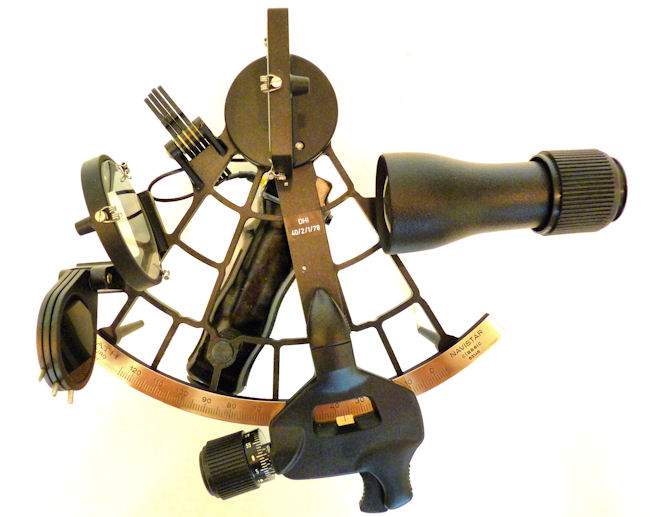
We
are the premier source for all versions of the Plath Navistar premium sextants and have sold more than any other dealer in
the world!
We have sold numerous examples of the Plath Navistar Classic and it derivatives
through the 1991 version which had a rectangular whole horizon horizon mirror and was made just before Plath sextant production
ceased. Of this group, we have seen none that were in as immaculate condition as this and also included mirrors that were
2 mm larger than on any other we’ve measured. Consequently, we classify it as in flawless
“Collector Quality” condition with 5 Plus Stars.
This is the 19th Navistar we’ve offered. In our opinion, they are the finest of the contemporary sextants.
They will be equally desirable at sea or in a collection of only the best, and should only appreciate in value.
CERTIFICATE OF ACCURACY:There are no papers
with this instrument, but we have tested it thoroughly and can guarantee it is in perfect condition with ZERO index and side
error. Based on our proprietary register of C. Plath instruments we can also date it by its serial number, 63145, as being
made in 1983.
WHOLE
HORIZON VS SPLIT IMAGE MIRROR: Traditional sextants have a split image mirror, silvered on one side, clear on
the other. It divides the field of view in two. On the clear side, there is a view of the sky, sea and horizon; on the other
side, a reflected view of the celestial object. The advantage of this type mirror is that slightly more light is reflected
through the telescope so that the image is brighter. If you are going to be taking a lot of twilight sights, you may find
this an advantage.
On the other hand, whole-horizon sextants use a mirror with a reflective
film over the entire surface that provides a full view of the horizon without interruption. This makes capturing the celestial
body much easier. If the preponderance of sights are to be taken during daylight, it is easier to use and much preferred.
The maker of the Astra III B sextant reports that 90% of their sales are with whole horizon mirrors.
The mirrors on this sextant and can be retrofitted with 57mm split image mirrors since
there is a flange on the frame upon which the smaller size mirror can rest..
 Perfect
Perfect
Whole horizon mirror
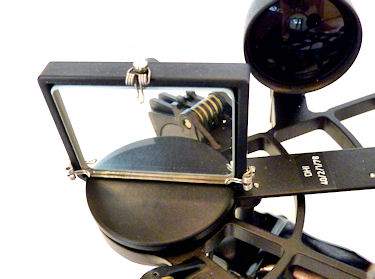
As New index mirror
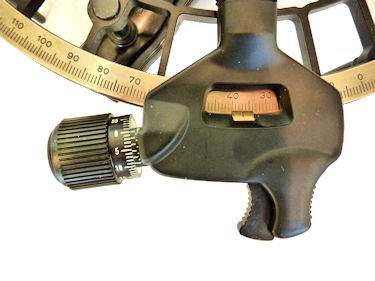 Special micrometer & vernier
Special micrometer & vernier
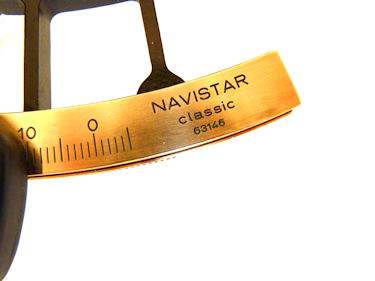 Navistar imprint & serial number
Navistar imprint & serial number
It has a flaming Mahogany wood case with energy absorbing green liner. The sextant
sits in the case with its handle up, ready for use, a handy feature. On its index arm is the Deutche Hydrographic Institute
seal of approval.
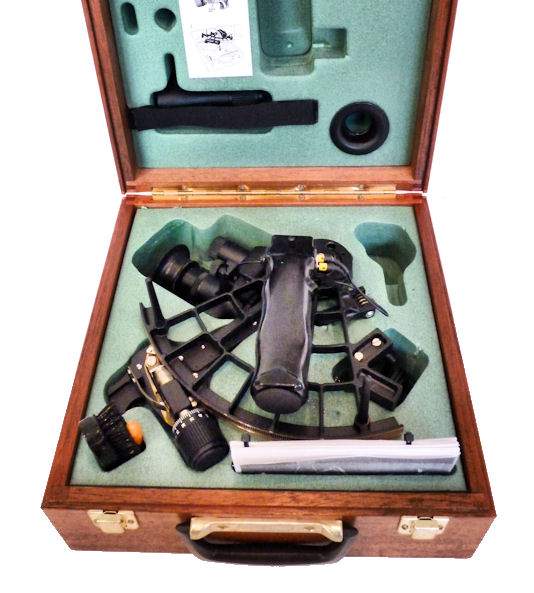
The Deutche
Hydrographic Institute stamp of approval elevates it to the highest level because it indicates this instrument was tested
by DHI, and found to meet the more stringent standards for commercial use. Hence, this sextant sold for more originally then
the regular Navistar Classic.
The Navistar
Classic was the top of the Plath line and was made in limited quantities, and was manufactured with a guaranteed non-adjustable
instrument error of 10 arc seconds or less. It sold for a premium over all its other sextants. For example, almost 30 years
ago, they sold for over $1000.00, and as recently as 2001, the price had risen to $4000.00.
 With 4 x 40 star scope fitted
With 4 x 40 star scope fitted
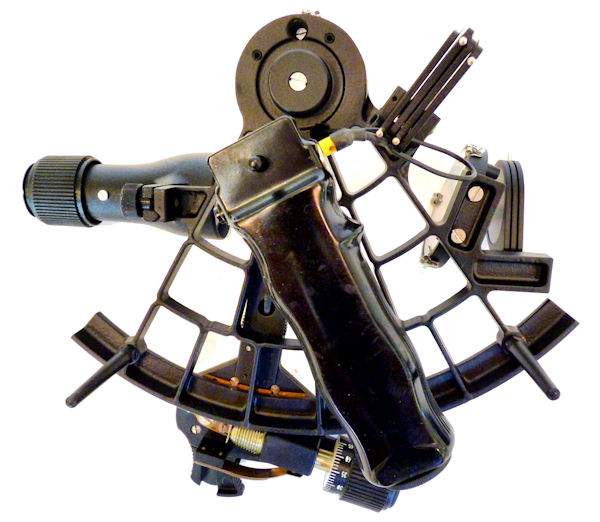 Back of
Back of
sextant
Don’t confuse this model with the similarly named “Navistar Professional“
which. in our opinion is the worst sextant made by Plath or the “Navistar Traditional“
which was made shortly before sextant production ended. That instrument has an error up to 20 arc seconds.
You can identify the “Navistar Classic” by these clues:
1. It has a special micrometer drum
2. The Navistar brand imprint on the arc.
3. The vernier has six indents and reads to 10 seconds of arc.
4. Comes with a fine wood case with a green absorbent liner,
5. And originally came with an instruction booklet, and Plath’s
certification
with matching numbers.
Some like this one have a label from the Deutche Hydrographic Institute dated 2/1/78 certifying them
for commercial service. All these features are present with this instrument except the certificate, and the manual included
is a photocopy.
For the seven year period from 1978 through
1985 only 1693 Navistar Classics were made. That is only 211 per year to satisfy worldwide demand.
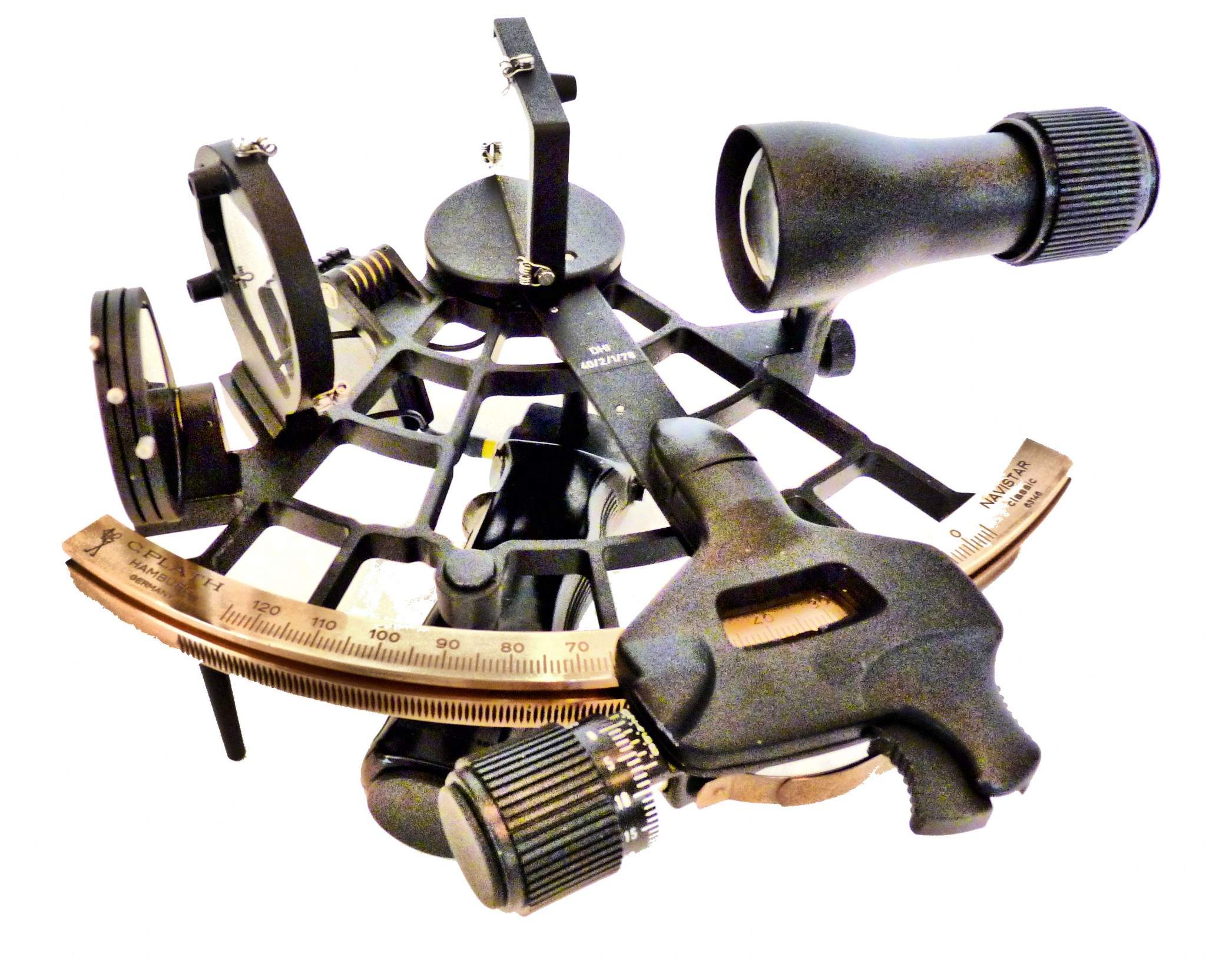
CONDITION: Appears to never have been used. Complete
with Plath’s version of a whole horizon mirror which they called Transflex, It
operates like a well oiled piece of machinery, with NO faults even minor ones. Both mirrors shows as NEW. All the chrome hardware
sparkles, and the illumination works. The bronze arc shows “as new”. All the paint is well bonded and looks fresh. There is
no index or side error. There is no certificate which is not uncommon, and unnecessary in C.Plath sextants since the Navistar
Classics were made to a tested accuracy of 10 arc seconds or less. For practical purposes this makes them error free in use.
The flame grain Mahogany, no lock, case case has some minor scuff and other marks from handling, otherwise it to is perfect.
Overall, it is one of the finest Navistar sextants we’ve ever offerred.
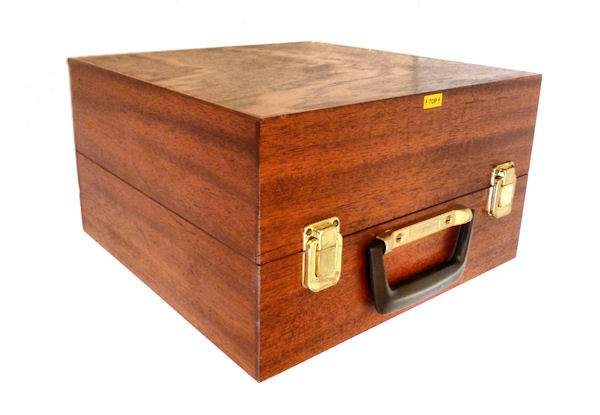 Sturdy Flaming Mahogany case
Sturdy Flaming Mahogany case
This C. Plath Navistar Classic
requires someone who can appreciate the fine points of a sextant, and is willing to pay an appropriate price for this level
of quality and excellence. It is suitable for a collector or for use at sea .
STAR
RATING: This fine Collector Quality instrument rates 5 PLUS STARS

QUALIFICATIONS:
We are one of the few company’s still selling navigation instruments that know anything about them. For purposes of judging
whether Joel’s opinion counts, he was the editor of the chapter on sextants of the 1977 Edition of “Bowditch”, The American
Practical Navigator, NAVPUB 9; a member of the U.S. Naval Academy Navigation Symposium, 1975 -1978; the author of a book on
marine sextants, Cornell Maritime Press,1975, and the founding president of Nautech Maritime Corporation which partnered with
Tamaya of Japan in the introduction of the MS 733 Spica, the MS 833, Jupiter, MS 933 Venus sextants and the famous NC-2 navigation
computer, in the U.S. market. Joel is a retired Master Mariner, and held a U.S. Navy “D” Qualification as a Senior Skipper
– Oceans. For six years he was a Varsity Offshore Sailing Team Coach at the U.S.
Naval Academy.
Some of his memberships have included the: Association
of Naval Aviation, Silver Wings, The Tailhook Association, Naval Academy Sailing Squadron, McCampbell’s Aces Squadron, Naval
Historical Foundation, and the Naval Order of the United States.
COMPANY HISTORY: In brief, Carl Plath started manufacturing sextants, in addition to other nautical
products, in Hamburg Germany in 1862 though the purchase of the David Filby instrument company though the company’s origin
dates back to 1837. As a result WW II, C.Plath was dismantled completely by the occupation forces. Around 1950, various prohibitions
were lifted, and C. Plath was allowed to begin production again of sextants and other nautical instruments. Also in 1949,C.Plath
was offered a gyrocompass patent and in 1951 the first gyrocompass designed to this patent was presented to the public. C.Plath
progressed from the role of instrument maker to that of a modern marine navigation equipment manufacturer. In the following
years the product range was expanded by many more modern designs such as autopilots, speed logs, radio direction finders,
etc.
In 1962
C.Plath was acquired by Litton Industries, a large American concern.The C.Plath North American Division was set up in 1978
in College Park near Washington. 1996 saw the introduction of the world’s first fiber-optic solid-state gyrocompass by C.Plath.
The first ever gyrocompass with no moving parts. Sperry Marine was formed in 1997 with the combination of C.Plath, Decca Marine
and Sperry Marine with more organizational changes yet to come. After 163 years, C.Plath changes its name to Sperry Marine
in May 2000. In 2001 Sperry Marine becomes part of the Northrop Grumman Corporation. In the 1990’s Plath came out with a series
of new sextant designs with overlapping designs and confusing names. They seemed to have lost their way. Shortly thereafter,
C. Plath quit producing sextants. The parent company has completely liquidated everything including machinery, equipment and
spare parts.
C.
PLATH NAVISTAR CLASSIC SPECIFICATIONS:
Measuring
Range: -5 to 125 degrees
Telescope: 4 x 40 Coated optics
Frame: Bronze
with black enamel paint and bronze arc.
Micrometer Drum and Vernier Scale: reads to 10 seconds of
arc
Index Mirror: 59 x 44 mm. aluminized on the rear side.
Horizon Mirror:
57.30 mm diameter.
Shades:
4 for index mirror
3 for
horizon mirror
Weight sextant: 4.2
lbs with 4 x 40 scope.
Weight case 6 lbs.
INCLUDED ARE:
1 C. Plath Sextant frame
1 4 x 40 star scope
1 Mirror adjustment tool
1 eye cup for telescope ocular lens
1
Varnished Flaming Mahogany sextant case
1 Copy of Navistar manual
